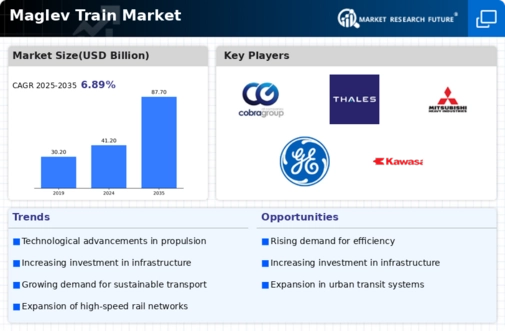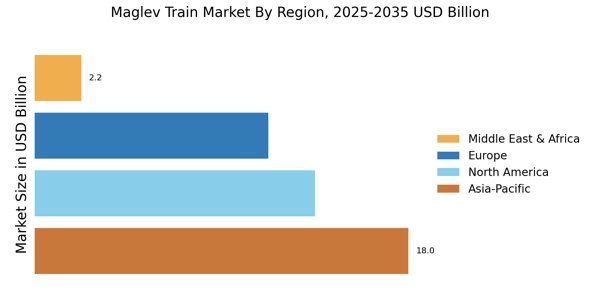Government Initiatives and Funding
Government initiatives and funding play a crucial role in the development of the Maglev Train Market. Many countries are recognizing the potential of maglev technology to revolutionize transportation and are allocating substantial budgets for research and infrastructure development. For example, recent government reports indicate that several nations have earmarked billions for the construction of maglev lines, aiming to enhance connectivity and reduce travel times. These initiatives often include public-private partnerships, which further stimulate investment in the maglev sector. As governments prioritize modern transportation solutions, the Maglev Train Market is likely to see increased activity and growth driven by supportive policies and funding.
Urbanization and Population Growth
Urbanization and population growth are significant factors influencing the Maglev Train Market. As urban areas expand and populations increase, the demand for efficient and rapid transportation solutions intensifies. Maglev trains, with their high-speed capabilities, offer a practical solution to alleviate congestion in densely populated regions. For instance, cities with populations exceeding 10 million are increasingly exploring maglev systems to connect urban centers with suburban areas. This trend is expected to drive investments in maglev infrastructure, as governments seek to enhance public transport systems. The Maglev Train Market stands to gain from this urban-centric approach, as more cities recognize the need for innovative transport solutions.
Competitive Landscape and Market Dynamics
The competitive landscape of the Maglev Train Market is evolving, with various players vying for market share. Established companies and new entrants are investing in research and development to innovate and improve maglev technologies. This competition is fostering a dynamic environment where advancements in speed, safety, and cost-effectiveness are prioritized. Market data suggests that the entry of new players could lead to a diversification of offerings, catering to different market segments. Additionally, collaborations between technology firms and transportation authorities are becoming more common, further enhancing the competitive dynamics. As the Maglev Train Market continues to mature, these factors are likely to shape its trajectory and influence future developments.
Sustainability and Environmental Considerations
The growing emphasis on sustainability is a pivotal driver for the Maglev Train Market. As nations strive to reduce carbon emissions and combat climate change, maglev trains present a viable alternative to traditional rail and road transport. With their ability to operate on electricity, often sourced from renewable energy, maglev trains contribute to lower greenhouse gas emissions. Reports indicate that maglev systems can reduce energy consumption by up to 30% compared to conventional trains. This eco-friendly aspect aligns with global initiatives aimed at promoting sustainable transportation solutions. Consequently, the Maglev Train Market is likely to benefit from increased investments and policy support focused on environmentally friendly transport options.
Technological Advancements in Maglev Train Market
The Maglev Train Market is experiencing rapid technological advancements that enhance the efficiency and performance of maglev systems. Innovations in superconducting materials and magnetic levitation technology are leading to trains that can achieve speeds exceeding 600 kilometers per hour. These advancements not only improve travel times but also reduce energy consumption, making maglev trains a more attractive option for transportation. Furthermore, the integration of advanced control systems and automation is streamlining operations, thereby increasing safety and reliability. As countries invest in modernizing their rail infrastructure, the demand for cutting-edge maglev technology is likely to rise, positioning the Maglev Train Market for substantial growth in the coming years.


















Leave a Comment